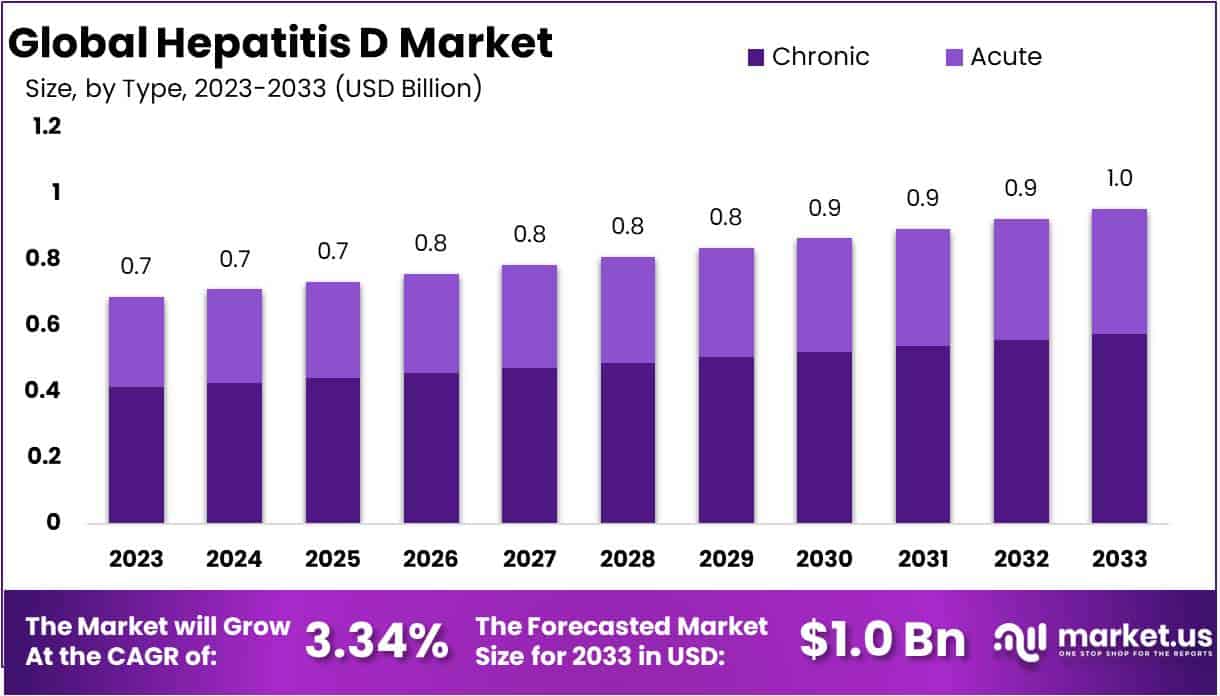Table of Contents
Introduction
The Global Hepatitis D Market is projected to grow from USD 0.7 billion in 2023 to approximately USD 1 billion by 2033, with a Compound Annual Growth Rate (CAGR) of 3.34% from 2024 to 2033. This growth is driven primarily by advancements in therapeutic treatments and heightened disease awareness, especially in regions where Hepatitis B (HBV) is prevalent. Hepatitis D (HDV) depends on HBV for replication, making regions with significant HBV rates critical areas for HDV intervention.
Recent medical advancements have introduced promising treatments targeting different stages of the HDV life cycle. Notably, Bulevirtide, an entry inhibitor approved by the European Medicines Agency (EMA), along with Lonafarnib, a prenylation inhibitor still under clinical trials, are improving liver function and slowing disease progression. These developments are pivotal, given HDV’s severe impact on liver health, potentially leading to cirrhosis and hepatocellular carcinoma if not appropriately managed.
Globally, the prevalence of HDV is closely linked to that of HBV, with significant occurrences in Asia, Africa, and the Amazon basin—areas where HBV remains endemic. Although HBV vaccinations have indirectly affected HDV rates, they have not eliminated the necessity for specific HDV-focused strategies. This underscores the importance of both preventative measures and effective therapeutic options in combating this co-infection.
In terms of clinical management, HDV infection often results in more severe liver disease compared to HBV alone. The interaction between HBV and HDV can accelerate the progression to serious liver conditions, making timely and effective diagnosis and management crucial. The standard diagnostic approach includes serum markers and liver function tests, with ongoing research and clinical trials continually refining these methods to enhance accuracy and treatment outcomes.
Addressing Hepatitis D requires a comprehensive strategy that encompasses medical advancements, public health initiatives, and continuous research. The objective is to improve understanding and management of this challenging co-infection, aiming to mitigate its severe health implications effectively. As treatments like Bulevirtide and Lonafarnib show promise, the focus remains on enhancing both preventive measures and therapeutic responses to HDV in affected regions.

Key Takeaways
- In 2023, the chronic hepatitis D type led the global Hepatitis D market, holding a substantial revenue share of 60.2%.
- Blood tests are the preferred diagnostic method by healthcare professionals, dominating the Hepatitis D market.
- Hospital pharmacies emerged as the leading distribution channel in the global Hepatitis D market.
- The increasing incidence of Hepatitis D viral infections is driving demand for medical treatments, thus fueling market growth.
- Potential side effects and high costs of Hepatitis D treatments could limit market growth in the future.
- In 2023, North America captured a significant market share, accounting for 52.4% of the global Hepatitis D market revenue.
Emerging Trends
- Advances in Diagnosis and Screening: Hepatitis D (HDV) progresses rapidly, leading to severe liver complications. Advanced diagnostic tests are becoming a priority to improve early detection. Healthcare providers are now focusing on enhanced screening tools, particularly for high-risk groups. Broader screening protocols are essential to identify more cases at an early stage. These efforts aim to prevent late-stage complications and ensure timely intervention. The growing availability of advanced diagnostic methods is helping clinicians detect HDV co-infections faster. More research is being conducted to refine these screening tools for better accuracy. Countries with high HBV and HDV prevalence are expanding their screening programs.
- New Therapeutic Developments: The approval of bulevirtide in Europe represents a major step forward in HDV treatment. It is the first approved therapy targeting HDV infection directly. Researchers are actively developing new drugs to improve patient outcomes. Several experimental treatments are undergoing clinical trials to expand treatment options. The goal is to create effective therapies that reduce liver damage and slow disease progression. Pharmaceutical companies are investing in novel antiviral approaches to combat HDV more efficiently. The demand for better treatment solutions is pushing innovation in the field. Experts believe combination therapies may offer improved results for patients with chronic HDV infections.
- Raising Awareness and Education: Increasing awareness about HDV among healthcare professionals and the public is crucial. Many people remain unaware of the risks associated with HDV and its transmission. Educational programs are being developed to improve understanding and management. These initiatives focus on high-risk populations, especially in regions with high HBV and HDV co-infections. Governments and healthcare organizations are launching awareness campaigns to promote early detection. Training programs are being introduced to help doctors diagnose HDV more effectively. Social media and digital platforms are also being used to spread information. The goal is to ensure more people receive timely testing and care.
- Global Health Initiatives and Access to Care: International health organizations are incorporating HDV into broader viral hepatitis programs. This is essential in regions where HBV and HDV co-infections are common. Efforts are being made to improve access to screening and treatment worldwide. Many countries are implementing new policies to enhance HDV diagnosis and care. Funding for research and public health initiatives is increasing to address this growing concern. Non-profit organizations and government agencies are working together to expand treatment availability. The push for universal healthcare access is helping more HDV patients receive medical attention. Collaborative efforts between nations aim to reduce HDV-related liver disease globally.
Use Cases
- Public Health Screening Programs: Routine HDV screening in areas with high HBV prevalence can help detect infections early. This reduces severe liver disease cases and improves patient outcomes. Screening programs should focus on high-risk groups like people with chronic HBV, injection drug users, and those in endemic regions. Early detection allows for timely treatment and better disease management. Governments and healthcare agencies should integrate HDV testing into existing HBV screening efforts. Awareness campaigns can encourage people to get tested. Providing affordable or free screening services in public hospitals can further increase participation. Strengthening these programs can lower overall HDV-related complications.
- Integrated Treatment Approaches: A combined approach to treating both HBV and HDV can improve disease management. Patients with HDV often experience rapid liver damage, making dual treatment crucial. Health systems should integrate HDV care into existing HBV programs. This approach ensures that patients receive proper antiviral therapies. Access to new treatment options like bulevirtide can improve outcomes. Coordinating care through liver specialists and infectious disease experts can enhance patient recovery. Government support for subsidized treatments can reduce financial barriers. Providing clear guidelines for doctors on HDV-HBV management will lead to better clinical outcomes. Expanding research into more effective combination treatments is also vital.
- Educational Campaigns: Raising awareness about HDV transmission and prevention can reduce infection rates. Many people with HBV do not know they are at risk for HDV. Educational programs should target high-risk groups, including healthcare workers, drug users, and HBV-positive individuals. Information campaigns can explain how HDV spreads, stressing the importance of vaccination and safe medical practices. Collaboration with local health agencies can improve outreach. Using social media, community workshops, and multilingual resources can enhance effectiveness. Schools and universities can also include HDV education in health curricula. Increasing knowledge can encourage early screening and preventive behaviors, lowering overall HDV transmission.
- Research and Development: Investing in new treatments and diagnostic tools for HDV is essential. Current treatment options are limited, and many patients struggle with severe liver complications. Pharmaceutical companies, governments, and research institutions must collaborate on developing targeted therapies. Clinical trials for HDV-specific drugs like entry inhibitors should receive more funding. Faster and more accurate diagnostic tests can improve early detection rates. Encouraging biotech startups to focus on HDV innovations could accelerate progress. Public-private partnerships can drive investment in this neglected disease area. Increased funding for global HDV research will lead to better treatment strategies and improved patient care.
- Global Surveillance Systems: Stronger surveillance systems can help monitor HDV prevalence and resistance patterns. Many countries lack comprehensive data on HDV infections. Standardized global reporting can provide insights into disease trends. Public health agencies should track HDV cases alongside HBV surveillance. Digital health tools and AI-driven analytics can improve data collection. Sharing findings with policymakers ensures better resource allocation. Strengthening reporting mechanisms can help detect outbreaks early. International organizations should support under-resourced nations in developing surveillance infrastructure. Better data will help shape prevention strategies and improve global health policies. Increasing global cooperation can lead to a more effective HDV response.
Conclusion
The Hepatitis D market is experiencing steady growth due to advancements in treatments, improved diagnostic tools, and rising disease awareness. The approval of new therapies and ongoing research into antiviral solutions are helping to improve patient outcomes. Increasing screening programs, particularly in high-risk regions, is essential for early detection and intervention. Public health initiatives and global collaborations are driving better access to care and treatment options. Educational campaigns are also playing a crucial role in spreading awareness about transmission risks and prevention strategies. As healthcare providers continue to refine diagnostic methods and treatment protocols, a comprehensive approach integrating prevention, treatment, and research will be key to reducing the burden of Hepatitis D worldwide.
Discuss your needs with our analyst
Please share your requirements with more details so our analyst can check if they can solve your problem(s)



